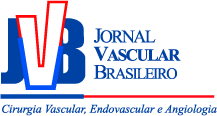Profilaxia de tromboembolismo venoso, podemos fazer melhor? Perfil de risco e profilaxia de tromboembolismo venoso em Hospital Universitário do interior do Estado de São Paulo
Venous thromboembolism, can we do better? Profile of venous thromboembolism risk and prophylaxis in a University Hospital in the State of São Paulo
Arthur Curtarelli; Luiz Paulo Correia e Silva; Paula Angeleli Bueno de Camargo; Rafael Elias Farres Pimenta; Rodrigo Gibin Jaldin; Matheus Bertanha; Marcone Lima Sobreira; Winston Bonetti Yoshida
Resumo
Palavras-chave
Abstract
Abstract:
Keywords
References
Guyatt GH, Eikelboom JW, Gould MK, et al. Approach to outcome measurement in the prevention of thrombosis in surgical and medical patients: Antithrombotic Therapy and Prevention of Thrombosis, 9th ed: American College of Chest Physicians Evidence-Based Clinical Practice Guidelines. Chest. 2012;141(2 Suppl):e185S-94S. http://dx.doi.org/10.1378/chest.11-2289.
Caprini JA, Arcelus JI, Reyna JJ. Effective risk stratification of surgical and nonsurgical patients for venous thromboembolic disease. Semin Hematol. 2001;38:12-9. http://dx.doi.org/10.1016/S0037-1963(01)90094-0.
Stinnett JM, Pendleton R, Skordos L, Wheeler M, Rodgers GM. Venous thromboembolism prophylaxis in medically ill patients and the development of strategies to improve prophylaxis rates. Am J Hematol. 2005;78(3):167-72. http://dx.doi.org/10.1002/ajh.20281.
Jacobson BF, Louw S, Buller H, et al. Venous thromboembolism: prophylactic and therapeutic practice guideline. S Afr Med J. 2013;103(4):261-7. http://dx.doi.org/10.7196/SAMJ.6706.
Caiafa JS, Bastos MD. Programa de profilaxia do tromboembolismo venoso do Hospital Naval Marcílio Dias: um modelo de educação continuada. J Vasc Bras. 2002;1:103-12.
Engelhorn CA, Nardelli J, Iwamura AP, Salgado LD, Hartmann MO, Witt NC. Drug prophylaxis of deep vein thrombosis in patients submitted to trauma surgery in a university hospital. J Vasc Bras. 2012;11(2):97-101. http://dx.doi.org/10.1590/S1677-54492012000200005.
Goldhaber SZ. DVT prevention: what is happening in the “real world”? Semin Thromb Hemost. 2003;29(Suppl 1):23-31. http://dx.doi.org/10.1055/s-2003-45414.
Deheinzelin D, Braga A, Martins L, et al. Incorrect use of thromboprophylaxis for venous thromboembolism in medical and surgical patients: results of a multicentric, observational and cross‐sectional study in Brazil. J Thromb Haemost. 2006;4(6):1266-70. http://dx.doi.org/10.1111/j.1538-7836.2006.01981.x.
Carneiro JLDA, Targueta GP, Marino LO. Avaliação da profilaxia do tromboembolismo venoso em hospital de grande porte; Evaluation of venous thromboembolism prophylaxis in a high complexity hospital. Rev Col Bras Cir. 2010;37(3):204-10. http://dx.doi.org/10.1590/S0100-69912010000300008.
Marchi C, Schlup IB, Lima CAD, Schlup HA. Avaliação da profilaxia da trombose venosa profunda em um hospital geral. J Vasc Bras. 2005;4:171-5.
Cohen AT, Tapson VF, Bergmann JF, et al. Venous thromboembolism risk and prophylaxis in the acute hospital care setting (ENDORSE study): a multinational cross-sectional study. Lancet. 2008;371(9610):387-94. http://dx.doi.org/10.1016/S0140-6736(08)60202-0.
Carandina RF. Revisão sistemática e metanálise do perfil de risco e profilaxia de tromboembolismo venoso no Brasil e no mundo. J Vasc Bras. 2016;15:339-40.
Argenta C, Beltrami L. Análise de custo-minimização do uso de heparina não-fracionada e enoxaparina em uma coorte de pacientes em tratamento de tromboembolismo venoso [dissertação]. Porto Alegre: Universidade Federal do Rio Grande do Sul; 2007 [citado 2018 out 16]. http://www.lume.ufrgs.br/handle/10183/11453
Spyropoulos AC, Hurley JS, Ciesla GN, Lissovoy G. Management of acute proximal deep vein thrombosis: pharmacoeconomic evaluation of outpatient treatment with enoxaparin vs inpatient treatment with unfractionated heparin. Chest. 2002;122(1):108-14. http://dx.doi.org/10.1378/chest.122.1.108.
Edo A, Fa B, Melo DSÂ, Alves da Costa TD, Fernandes MC, Fernandes MC. Fatores de risco e profilaxia para tromboembolismo venoso em hospitais da cidade de Manaus. J Bras Pneumol. 2009;35(2):114-121.
Rocha ATC, Paiva EFD, Araújo DMD, et al. Impacto de um programa para profilaxia de tromboembolismo venoso em pacientes clínicos em quatro hospitais de Salvador. Rev Assoc Med Bras. 2010;56(2):197-203. http://dx.doi.org/10.1590/S0104-42302010000200019.
Sociedade Brasileira de Angiologia e de Cirurgia Vascular – SBACV. Normas de orientação clínica para a prevenção, o diagnóstico e o tratamento da trombose venosa profunda. J Vasc Bras. 2005;2005:S185-94.
Engelhorn ALV, Garcia ACF, Cassou MF, Birckholz L, Engelhorn CA. Profilaxia da trombose venosa profunda-estudo epidemiológico em um hospital escola. J Vasc Bras. 2002;1:97-102.
Garcia ACF, Souza BVD, Volpato DE, et al. Realidade do uso da profilaxia para trombose venosa profunda: da teoria à prática. J Vasc Bras. 2005;4:35-41.
Pereira CA, Brito SSD, Martins AS, Almeida CM. Profilaxia da trombose venosa profunda: aplicação prática e conhecimento teórico em um hospital geral. J Vasc Bras. 2008;7(1):18-27. http://dx.doi.org/10.1590/S1677-54492008000100005.
Geerts WH, Heit JA, Clagett GP, et al. Prevention of venous thromboembolism. Chest. 2001;119(1, Suppl):132S-75S. http://dx.doi.org/10.1378/chest.119.1_suppl.132S.
House of Commons Health Committee. The prevention of venous thromboembolism in hospitalised patients. Second report of session 2005. London: The Stationery OYce Limited; 2005. Ordered by The House of Commons to be printed 23 February 2005.



